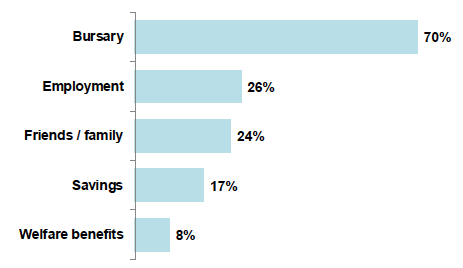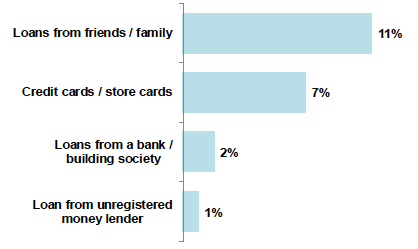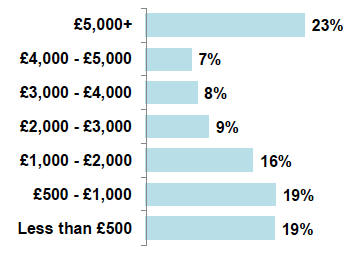Student funding in further education
Research into the financial behaviour of further education students in Scotland, exploring demand for and potential impact of student loans amongst this group.
5. Key findings: Current sources of financial support
Chapter summary
- Most research participants were in receipt of a bursary, which was often being topped up with income from other sources.
- The other most commonly cited sources of income for FE students were employment, support from friends / family, savings and welfare benefits.
- Feedback on wider impacts of student employment was mixed – in some cases it was viewed positively and in others it was found to be having a detrimental impact on students' health, wellbeing and college attainment.
- The bursary system was thought to be confusing, with a general lack of clarity and transparency around eligibility criteria and entitlements.
- The prevalence of debt amongst the FE student population was found to be broadly in line with the national average for the adult population.
- Friends and family were the most common source of lending for FE students and relatively few were found to have taken out commercial credit whilst in college.
- There were wide variations in the levels of debt that students had, although most owed less than £5k.
Introduction
5.1 This chapter reports on the current sources of financial support being accessed by the FE students that participated in the research. It begins with an overview of the main sources of income reported, followed by discussion of levels and sources of debt.
Sources of income
Most research participants were in receipt of a bursary, which was often being topped up with income from other sources.
5.2 Most of the students who completed the survey (70%) were receiving a bursary (Figure 5‑1: ). This was the most commonly cited source of income amongst both survey and focus group participants. The amount of bursary that students received varied depending on individual circumstances, but most focus group participants were of the view that it was not enough to live on and most were supplementing it with income from other sources.
5.3 The other most commonly cited sources of income for students were:
- Employment – around a quarter of survey respondents were in work
- Friends / family – around a quarter were being supported by friends / family, particularly parents and partners, but also children in some cases
- Savings – around one in every six had access to savings to support them whilst in college
- Welfare benefits – less than 10% of survey respondents were in receipt of welfare benefits. Of these, the most commonly cited were child benefit, council tax benefit and child tax credit.
Figure 5‑1: Which of the following sources of income have you accessed whilst at college? Please select all that apply.

Source: SQW Survey of FE Students
Base: 2,028
Feedback on the wider impacts of employment was mixed and there were several examples of where this was having a detrimental impact on students' health, wellbeing and college performance.
5.4 Around a third (31%) of focus group participants were in work. In some cases, this was viewed positively – it enabled students to gain valuable experience and reduced the pressure on their families to support them. However, there were several examples through the focus groups of where this was found to be having a negative impact on their health and wellbeing and of students working night shifts and going straight into college for a full day afterwards.
5.5 In almost all cases, the focus group students who were in employment said they had no choice – it was an essential source of income to enable them to stay in college. In addition to health impacts, this was frequently reported to be having a negative impact on their performance at college as they were tired during classes or falling behind with coursework. For this reason, a small number of students made a conscious decision not to pursue employment as they wanted to be able to focus completely on their course, even if that meant they had to do without essentials.
The bursary system was thought to be confusing, with a lack of clarity and transparency around eligibility criteria and entitlements.
5.6 A key topic of discussion during the focus groups was the eligibility criteria for bursaries, which most students thought were unfair because they were based on household income and did not take account of outgoings, including the number of dependents within a household. It was also thought to be based on an assumption that students who were living with their parents were also being financially supported by them, which was not always the case.
"People get penalised for living at home with their parents even when they are not being supported by them."
"It's not great, especially for parents or if you are part of a couple. There is no guidance about financial options."
Focus Group Participants
5.7 There was a perceived lack of clarity, transparency and equity in how bursary decisions were made. This left many students feeling that they were not getting as much as they should be entitled to (or that they expected) when they made the decision to go to college. Several students expressed disappointment that they were not being given access to adequate financial support to enable them to pursue their studies.
5.8 A further source of concern shared in the focus groups was the challenging and time consuming bursary administration process, mainly due to the evidence requirements. Other issues raised related to: not being kept up to date on the status of applications; IT issues delaying the process for checking applications; administration errors resulting in delayed payments; uncertainty around payment schedules; and lack of clarity around how bursaries interact with other types of welfare benefits.
Sources of debt
The prevalence of unsecured personal debt amongst the FE student population was found to be broadly in line with the national average.
5.9 Approximately 700 survey respondents said that they were currently in debt, accounting for around one third (34%) of respondents. Possible reasons for those students reporting no debt include:
- Eligibility – 26% of survey respondents said that they had been turned down for a loan, mortgage or credit card. This was a theme in several of the focus group discussions, where students said that they did not qualify for credit due to their low income and / or poor credit rating
- Negative attitudes towards taking on debt – although many focus group participants were in difficult financial circumstances, and indeed did not have enough money to feed themselves, many said that they would not consider taking on debt
- Not needed – some students, particularly the younger ones who were living at home with their parents, did not have any major financial worries.
Friends / family were the most common source of lending for FE students, whilst relatively few were found to have taken out commercial debt whilst in college.
5.10 Around one in every ten survey respondents (11%) had taken out loans from friends / family whilst at college, whilst less than 10% had accessed commercial credit (Figure 5‑2). The use of both commercial credit, including credit cards and bank loans, and loans from friends/family was much more prevalent amongst focus group participants than those responding to the survey[33], perhaps reflecting those who self-selected to attend the focus groups. Loans from friends and family were used by around 30% of focus group students as a source of income, with four in five students also using commercial credit. This may be because the study over sampled from students with certain protected characteristics and disadvantaged backgrounds who were more likely to have overall higher levels of debt.
Figure 5‑2: Which of the following sources of finance have you accessed whilst at college? Please select all that apply.

Source: SQW Survey of FE Students
Base: 2,028
There were wide variations in the levels of debt that students had, although most owed less than £5k.
Figure 5‑3: How much debt are you in?

Source: SQW Survey of FE Students
Base: those who said they were in debt (703)
5.11 Figure 5‑3 shows the variations between survey respondents in relation to the level of unsecured debt that they were in. Around a quarter (23%) owed more than £5,000, whilst at the other end of the scale a fifth (19%) owed less than £1,000Error! Reference source not found..
5.12 Overall, this could be considered broadly in line with the average unsecured personal debt for the adult population as a whole. In 2017 the average level of unsecured personal debt in the UK was estimated at £3.3k and £3.4k in Scotland[34]. However, from the survey sample the student population is not expected to be a cross-section of the wider population.
Contact
Email: fraser.syme@gov.scot
There is a problem
Thanks for your feedback